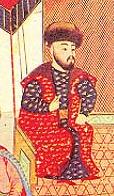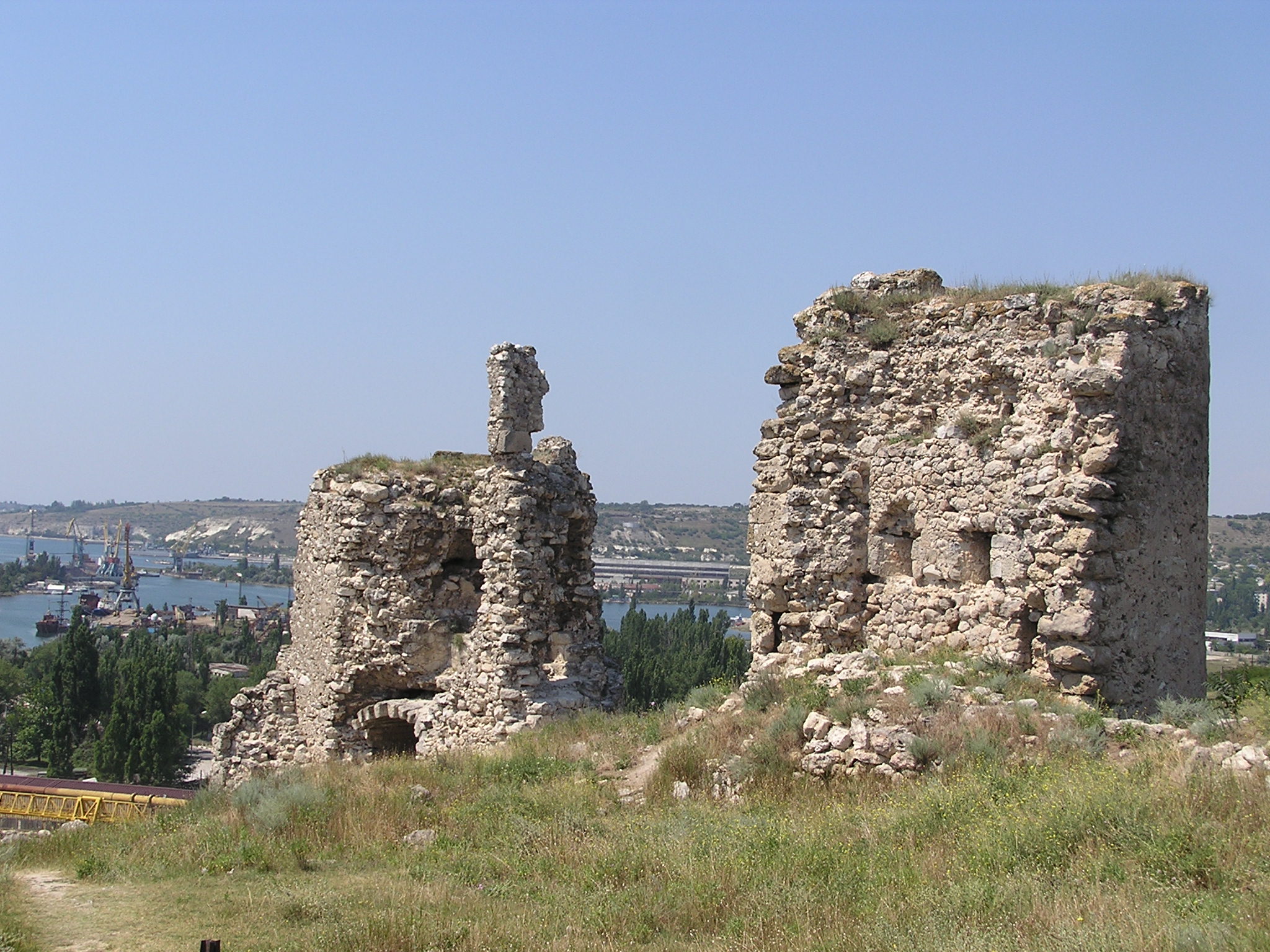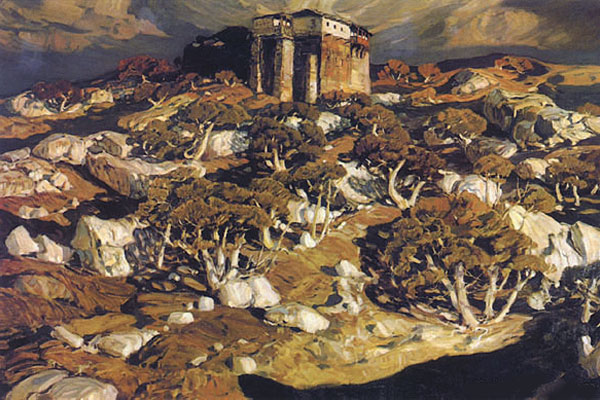|
Hacı I Giray
Hacı I Giray (1397–1466, ruled circa 1441–1466) was the founder of the Crimean Khanate and the Giray dynasty of Crimea. As the Golden Horde was breaking up, he established himself in Crimea and spent most of his life fighting off other warlords. He was usually allied with the Lithuanians. His name has many spellings, such as Haji-Girei and Melek Haji Girai ( crh3, Bır Hacı Geray, بیر-حاجى كراى; ', ). He is said to have introduced the new state symbol, ''taraq tamğa'', or "the trident of the Girays", which is derived from the scales insignia of the Golden Horde. A contemporary European source, ''The Chronicle of Dlugosz'', described him as a person of outstanding personal values and a perfect governor. Origin of the Girays Milner (1855) tells this story. His original name was Devlet. He was called Haji although there seems to be no evidence that he had made the Hajj. As a boy, when his family was defeated, he was protected by a shepherd. When he grew powerf ... [...More Info...] [...Related Items...] OR: [Wikipedia] [Google] [Baidu] |
List Of Crimean Khans
This is a list of khans of the Crimean Khanate, a state which existed in present-day southern Ukraine from 1441 until 1783. Crimean Tatars, although not a part of the Ukrainian ethnos, are deeply interconnected, having ruled a large part of modern Ukraine over the span of 300 years. The position of Khan in Crimea was electoral and was picked by beys from four of the most noble families (also known as Qarachi beys: Argyns, Kipchaks, Shirins, and Baryns) at kurultai where the decision about a candidate was adopted.Giray - Khan dynasty of Crimea Khan's Palace website (unavailable currently). The newly elected Khan was raised on a white sheet and over him were ... [...More Info...] [...Related Items...] OR: [Wikipedia] [Google] [Baidu] |
Adil Giray
Adil Giray, Adil Khan Girai ( crh3, Adil Geray, عادل كراى) was khan of the Crimean Khanate from 1666 to 1671. Family He is said to have been the grandson of Fetih I Giray (see below). His father was killed in battle in 1624 when the Turks tried to overthrow Mehmed III Giray. None of his descendants were khans. His elder brother Fetih was nureddin in 1641-44 during the first reign of Mehmed IV Giray. His kalga and nureddin were Devlet and Gazi, sons of his brother Fetih. Another Adil Giray was one of the many sons of Selâmet I Giray. He served as nureddin under his brothers İslâm III Giray and Mehmed IV Giray circa 1651 to before 1666. His son was Devlet III Giray (1716-1717). He was killed by a fall from a horse. Reign In 1666 he was placed on the throne by the Ottomans, who were displeased with khan Mehmed IV. At the time he was in exile at Rhodes. He came into conflict with his nobles, especially the Shirin clan, because of his questionable ancestry and high ... [...More Info...] [...Related Items...] OR: [Wikipedia] [Google] [Baidu] |
Balaklava
Balaklava ( uk, Балаклáва, russian: Балаклáва, crh, Balıqlava, ) is a settlement on the Crimean Peninsula and part of the city of Sevastopol. It is an administrative center of Balaklava Raion that used to be part of the Crimean Oblast before it was transferred to Sevastopol Municipality. Population: History Balaklava has changed possession several times during its history. A settlement at its present location was founded under the name of Symbolon () by the Ancient Greeks, for whom it was an important commercial city. During the Middle Ages, it was controlled by the Byzantine Empire and then by the Genoese who conquered it in 1365. The Byzantines called the town Yamboli and the Genoese named it Cembalo. The Genoese built a large trading empire in both the Mediterranean and the Black Sea, buying slaves in Eastern Europe and shipping them to Egypt via the Crimea, a lucrative market hotly contested with by the Venetians. The ruins of a Genoese fortres ... [...More Info...] [...Related Items...] OR: [Wikipedia] [Google] [Baidu] |
Principality Of Theodoro
The Principality of Theodoro ( el, Αὐθεντία πόλεως Θεοδωροῦς καὶ παραθαλασσίας), also known as Gothia ( el, Γοτθία) or the Principality of Theodoro-Mangup, was a Greek principality in the southern part of Crimea, specifically on the foothills of the Crimean Mountains. It represented one of the final rump states of the Eastern Roman Empire and the last territorial vestige of the Crimean Goths until its conquest by the Ottoman Empire by the Ottoman Albanian Gedik Ahmed Pasha in 1475. Its capital was Doros, also sometimes called Theodoro and now known as Mangup. The state was closely allied with the Empire of Trebizond. History In the late 12th century, the Crimean peninsula had seceded from the Byzantine Empire, but soon after the sack of Constantinople in 1204 parts of it were included in the Trapezuntine '' Gazarian Perateia''. This dependence was never very strong and was eventually replaced by the invading Mongols, who in 12 ... [...More Info...] [...Related Items...] OR: [Wikipedia] [Google] [Baidu] |
Chufut-Kale
__NOTOC__ Chufut-Kale ( crh, Çufut Qale, italic=yes ; Russian and Ukrainian: Чуфут-Кале - ''Chufut-Kale''; Karaim: Кала - קלעה - ''Kala'') is a medieval city-fortress in the Crimean Mountains that now lies in ruins. It is a national monument of Crimean Karaites culture just east of Bakhchisaray. Its name is Crimean Tatar and Turkish for " Jewish Fortress" (''çufut/çıfıt'' - Jew, ''qale/kale'' - fortress), while Crimean Karaites refer to it simply as "Fortress", considering the place as historical center for the Crimean Karaite community. In the Middle Ages the fortress was known as ''Qırq Yer'' (Place of Forty) and as Karaites to which sect the greater part of its inhabitants belong, ''Sela' ha-Yehudim'' (Hebrew for 'Rock of the Jews'). Name versions * Чуфут-Кале (Russian transliteration: Chufut Kale) is mentioned in the Soviet scientific literature, as well as in the works of Karaite authors in the Russian language from the second half of the ... [...More Info...] [...Related Items...] OR: [Wikipedia] [Google] [Baidu] |
Stary Krym
Staryi Krym (russian: Старый Крым; uk, Старий Крим; crh, Eski Qırım, italic=yes; in all three languages) is a small historical town and former bishopric in Kirovske Raion of Crimea, Ukraine. It has been illegally occupied by Russia since 2014 (see Annexation of Crimea by the Russian Federation). It is located in the Eastern Crimean Peninsula, approximately 25 km (15 mi.) west of Theodosia. Population: Names During the late 13th century, the town was known as either ''Solkhat'' (''Solkhad'', ''Solghad'', ) or as ''Qrım'' ( ). Neither name is attested prior to the 13th century, but on the authority of al-Qalqashandi, ''Solkhat'' is the older of the two, dating to the period prior to the Mongol conquest in mid-1238. Both names coexisted during the 14th century, but the name ''Qırım'' came to displace ''Solkhat'' by the early 15th. The origin of either name is uncertain. Some consider ''Solkhat'' to be related to the Greek ''Colchis''. ... [...More Info...] [...Related Items...] OR: [Wikipedia] [Google] [Baidu] |
Vytautas
Vytautas (c. 135027 October 1430), also known as Vytautas the Great (Lithuanian: ', be, Вітаўт, ''Vitaŭt'', pl, Witold Kiejstutowicz, ''Witold Aleksander'' or ''Witold Wielki'' Ruthenian: ''Vitovt'', Latin: ''Alexander Vitoldus'', Old German: ''Wythaws or Wythawt'') from the late 14th century onwards, was a ruler of the Grand Duchy of Lithuania. He was also the Prince of Grodno (1370–1382), Prince of Lutsk (1387–1389), and the postulated king of the Hussites. In modern Lithuania, Vytautas is revered as a national hero and was an important figure in the national rebirth in the 19th century. ''Vytautas'' is a popular male given name in Lithuania. In commemoration of the 500-year anniversary of his death, Vytautas Magnus University was named after him. Monuments in his honour were built in many towns in the independent Lithuania during the interwar period from 1918 to 1939. It is known that Vytautas himself knew and spoke in the Lithuanian language with Jogai ... [...More Info...] [...Related Items...] OR: [Wikipedia] [Google] [Baidu] |
Küchük Muhammad
Küchük Muḥammad or Kīchīk Muḥammad (; 28 June 1391 – 1459) was a Mongol Khan of the Golden Horde from 1433 until his death in 1459. He was the son of Tīmūr Khan, possibly by a daughter of the powerful beglerbeg Edigu. His name, "Little Muḥammad," was intended to distinguish him from a rival and older contemporary, Ulugh Muḥammad, "Big Muḥammad." Küchük Muḥammad started out as would-be khan at (old) Astrakhan from c. 1428, supported by his possible uncles, Ghāzī and Nawrūz, the sons of Edigu. A quarrel with the emir Nawrūz cost Küchük Muḥammad his desertion to Ulugh Muḥammad, and for a long time neither khan could eliminate his rival. However, Ulugh Muḥammad alienated more of his leading emirs, like Tekne and Ḥaydar, who deserted him to set up their own khan, Sayyid Aḥmad, son of Beg Ṣūfī, in 1432. Weakened by this, Ulugh Muḥammad came to terms with Küchük Muḥammad in 1432 or 1433, dividing the Golden Horde along the Volga, Ulugh ... [...More Info...] [...Related Items...] OR: [Wikipedia] [Google] [Baidu] |
Ulugh Muhammad
Ulugh Muhammad (1405–1445; ; tt-Cyrl, Олуг Мөхәммәт, translit=Oluğ Möxəmmət; written as Ulanus by orientalists) was a medieval Tatar statesman, Gengisid, Khan of the Golden Horde (before 1436), ruler of Crimea (1437), and the founder of the Khanate of Kazan, which he ruled from 1438-1445. He was the son of the oglan Ichkile Hassan and the cousin of Tokhtamysh. He received the nickname "Ulugh", meaning older or large, in contrast to another Muhammed who was called "Kichi", meaning younger or small. Ulugh Muhammad was Khan of the Golden Horde in 1419-1423, 1426, 1428. In 1428-1432 he waged a stubborn struggle for possession of the Ulug Ulus with the representatives of a minor branch of the Tukaytimurids (one of the branches of the Gengisids). After being defeated, Ulugh Muhammad escaped to Volga Bulgaria vilayet in 1423. With the support Vytautas, Ulugh Muhammad was able to regain the throne of the Golden Horde in 1426. He succeeded in spreading the power of th ... [...More Info...] [...Related Items...] OR: [Wikipedia] [Google] [Baidu] |
Barak Khan
Barak ( fa, ) was Khan of the Golden Horde from 1423 to 1429. His father was Quyurchuq, the son of Urus Khan, who was a descendant of Tuqa-Timur, the son of Jochi, the eldest son of Genghis Khan. Barak took support from Ulugh Beg, the Timurid khan, and in 1422 he dethroned Kepek, Ulugh Muhammad as well as Dawlat Berdi, khans of the Golden Horde. And Barak Khan reoccupied Sighnak from the Timurids. However, he was defeated in 1427 by Ulugh Muhammad and was promptly assassinated by Jochi's descendant, Mohammed, who claimed the steppe between the Ural and Syr Darya rivers for his dynasty. In the 1460s, Barak’s sons, Kirai and Janibek rebelled against Abu'l-Khayr Khan and they immigrated to the environs of Jeti Su (Seven Rivers) and established the Kazakh Khanate. Genealogy *Genghis Khan *Jochi *Tuqa-Timur *Urung-Timur (Uz-Timur, Urungbash) *Achiq *Taqtaq *Timur Khwaja *Badiq * Urus (?-1377) *Quyurchuq Quyurchuq (Qūyūrčuq) The name is found in various renditions, inc ... [...More Info...] [...Related Items...] OR: [Wikipedia] [Google] [Baidu] |
Sarai (city)
Sarai (also transcribed as ''Saraj'' or ''Saray'', from Persian ''sarāy'', "mansion" or "court") was the name of possibly two cities near the lower Volga, that served successively as the effective capitals of the Golden Horde, a Turco-Mongol kingdom which ruled much of Northwestern Asia and Eastern Europe, in the 13th and 14th centuries. There is considerable disagreement among scholars about the correspondence between specific archaeological sites and the various references to ''Sarāy'', ''Sarāy-i Bātū'' ("the Sarai of Batu"), ''Sarāy-i Barka'' ("the Sarai of Berke"), ''Sarāy al-Jadīd'' ("New Sarai"), and ''Sarāy al-Maḥrūsah'' ("Sarai Blessed y God) in the historical sources. Old Sarai "Old Sarai" was established by the Mongol ruler Batu Khan (1227-1255), as indicated by both occasional references to the "Sarai of Batu" ("Sarai Batu", ''Sarāy-i Bātū'') and an explicit statement of the Franciscan William of Rubruck, who visited Batu in 1253 or 1254, on ... [...More Info...] [...Related Items...] OR: [Wikipedia] [Google] [Baidu] |
Edigu
Edigu (or Edigey) (also İdegäy or Edege Mangit) (1352–1419) was a Mongol Muslim emir of the White Horde who founded a new political entity, which came to be known as the Nogai Horde. Edigu was from the Crimean Manghud tribe, the son of Baltychak, a Mongol noble who was defeated and killed by Khan Tokhtamysh of the Golden Horde in 1378. He gained fame as a highly successful general of Tokhtamysh before turning the arms against his master. By 1396, he was a sovereign ruler of a large area stretching between the Volga and Ural (known locally as Yayyk) rivers, which would later be called the Nogai Horde. In 1397, Edigu allied himself with Timur-Qutlugh and was appointed General and commander-in-chief of the Golden Horde armies. In 1399 he inflicted a crushing defeat on Tokhtamysh and Vytautas of Lithuania at the Vorskla River. Thereupon he managed to unite under his rule all Jochi's lands, albeit for the last time in history. In 1406, he located his old enemy Tokh ... [...More Info...] [...Related Items...] OR: [Wikipedia] [Google] [Baidu] |





